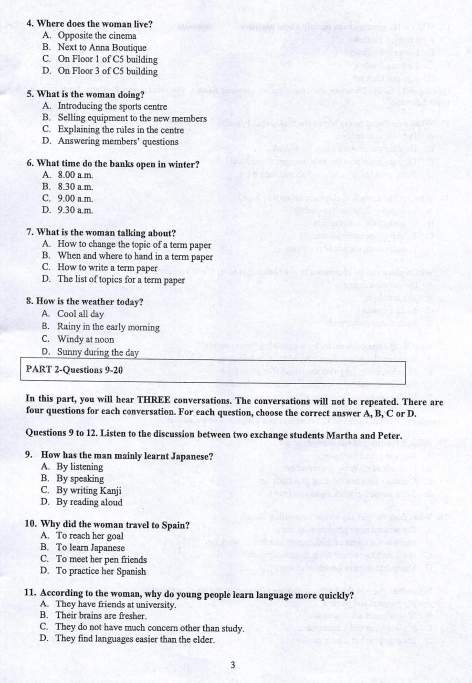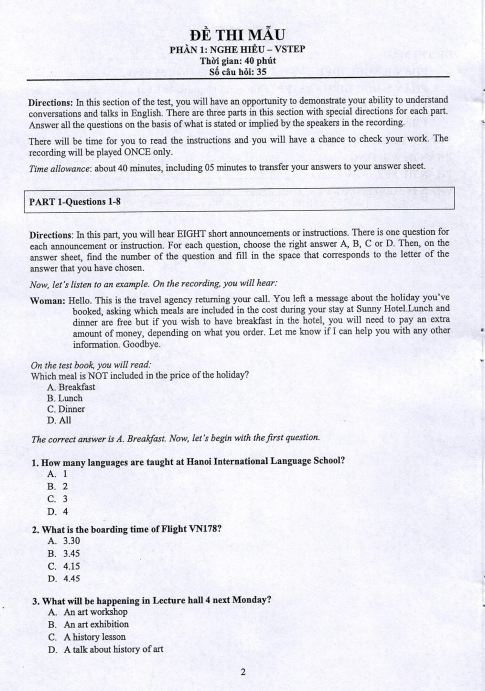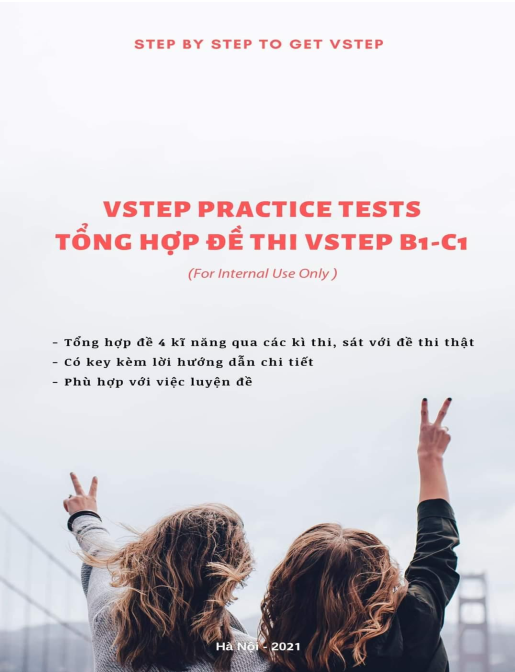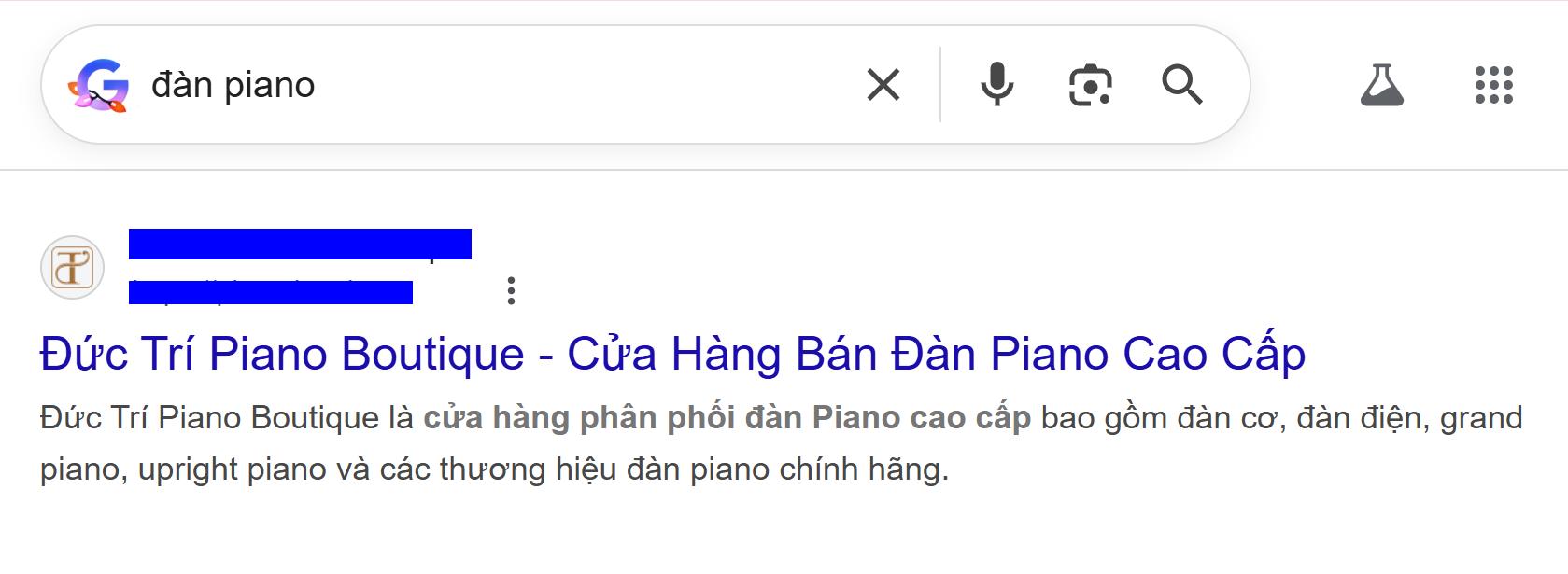


ĐỀ THI MẪU
NGHE HIỂU – VSTEP
Thời gian: 40 phút
Số câu hỏi: 35
Directions: In this section of the test, you will have an opportunity to demonstrate your ability to understand conversations and talks in English. There are three parts in this section with special directions for each part. Answer all the questions on the basis of what is stated or implied by the speakers in the recording.
There will be time for you to read the instructions and you will have a chance to check your work. The recording will be played ONCE only.
Time allowance: about 40 minutes, including 05 minutes to transfer your answers to your answer sheet.
Mục lục
TogglePART 1 – Questions 1–8
Directions: In this part, you will hear EIGHT short announcements or instructions. There is one question for each announcement or instruction. For each question, choose the right answer A, B, C or D. Then, on the answer sheet, find the number of the question and fill in the space that corresponds to the letter of the answer that you have chosen.
Now, let’s listen to an example. On the recording, you will hear:
Woman: Hello. This is the travel agency returning your call. You left a message about the holiday you’ve booked, asking which meals are included in the cost during your stay at Sunny Hotel. Lunch and dinner are free but if you wish to have breakfast in the hotel, you will need to pay an extra amount of money, depending on what you order. Let me know if I can help you with any other information. Goodbye.
On the test book, you will read:
Which meal is NOT included in the price of the holiday?
A. Breakfast
B. Lunch
C. Dinner
D. All
The correct answer is A. Breakfast. Now, let’s begin with the first question.
1. How many languages are taught at Hanoi International Language School?
A. 1
B. 2
C. 3
D. 4
2. What is the boarding time of Flight VN178?
A. 3.30
B. 3.45
C. 4.15
D. 4.45
3. What will be happening in Lecture hall 4 next Monday?
A. An art workshop
B. An art exhibition
C. A history lesson
D. A talk about history of art
4. Where does the woman live?
A. Opposite the cinema
B. Next to Anna Boutique
C. On Floor 1 of C5 building
D. On Floor 3 of C5 building
5. What is the woman doing?
A. Introducing the sports centre
B. Selling equipment to the new members
C. Explaining the rules in the centre
D. Answering members’ questions
6. What time do the banks open in winter?
A. 8.00 a.m.
B. 8.30 a.m.
C. 9.00 a.m.
D. 9.30 a.m.
7. What is the woman talking about?
A. How to change the topic of a term paper
B. When and where to hand in a term paper
C. How to write a term paper
D. The list of topics for a term paper
8. How is the weather today?
A. Cool all day
B. Rainy in the early morning
C. Windy at noon
D. Sunny during the day
PART 2 – Questions 9–20
In this part, you will hear THREE conversations. The conversations will not be repeated. There are four questions for each conversation. For each question, choose the correct answer A, B, C or D.
Questions 9 to 12. Listen to the discussion between two exchange students Martha and Peter.
9. How has the man mainly learnt Japanese?
A. By listening
B. By speaking
C. By writing Kanji
D. By reading aloud
10. Why did the woman travel to Spain?
A. To reach her goal
B. To learn Japanese
C. To meet her pen friends
D. To practice her Spanish
11. According to the woman, why do young people learn language more quickly?
A. They have friends at university.
B. Their brains are fresher.
C. They do not have much concern other than study.
D. They find languages easier than the elder.
12. What is the conversation mainly about?
A. Learning English
B. Learning languages
C. Learning French
D. Age and learning
Questions 13 to 16. Listen to the conversation between Emma, the tourist and Felipe, a local person from Ecuador.
13. What does the man say about the Galapagos Islands?
A. They are unattractive.
B. They are a must-visit place for tourists.
C. They are more popular with foreigners than locals.
D. There are a lot of famous hotels and food there.
14. Why are the costs in Galapagos Islands so high?
A. To improve their service quality
B. To protect the environment
C. To attract international tourists
D. To solve local economic problems
15. Which place can be compared to the Galapagos in terms of scenery?
A. The Amazon region
B. The lowlands
C. South Ecuador
D. Ecuadorean countryside
16. What do the speakers mean by mentioning “more rights”?
A. Islanders should have more freedom to do business.
B. Ecuadorians should visit the island with more ease.
C. Tourists should be given more freedom on the island.
D. Visitors should be encouraged to visit the island.
Questions 17 to 20. Listen to the conversation between Todd and Katia.
17. What is the topic of the conversation?
A. Ways to get an internship
B. Methods of studying at university
C. Contrasts between working and studying
D. Skills needed in working environment
18. What does the girl say about presenting skills?
A. She wanted more practice with them.
B. She was not aware of their importance before working.
C. She didn’t know how to do them in Spanish.
D. She taught them to herself at university.
19. What does the girl think about making mistakes in the working world?
A. It’s frequent and natural.
B. It’s undesirable but normal.
C. It’s worrying and unacceptable.
D. It’s annoying but totally avoidable.
20. What advice does the girl have for those about going to start working?
A. Prepare themselves for unexpected situations
B. Relax and have some fun
C. Make good transition from university to work
D. Make their best effort and follow their passion
PART 3 – Questions 21–35
In this part, you will hear THREE talks or lectures. The talks or lectures will not be repeated. There are five questions for each talk or lecture. For each question, choose the right answer A, B, C or D.
Questions 21 to 25. Listen to a presentation about summer job searching.
21. What factor deserves initial consideration when a summer job search is launched?
A. Sort of jobs within the field
B. Flexible working hours
C. Employees’ hobbies
D. Commitment to the job
22. Why does the speaker mention photography?
A. To highlight the importance of hobbies in job searching
B. To illuminate a job search process
C. To prove the role of local area in job searching
D. To suggest looking for a job on the internet
23. What principle does a person necessarily stick to when looking for the second job?
A. Value the second job over the current one
B. Ask for the current employer’s permission
C. Make all the contact out of company time
D. Have interviews scheduled during official working hours
24. What behavior will place a candidate at a great advantage in an interview?
A. Showing up on time
B. Having a great outfit
C. Stressing the achievements with the current company
D. Emphasizing the working experiences
25. What is of greatest importance for a successful attempt at the job search?
A. Asking for references from the current company
B. Referring to what have been achieved in the current job
C. Getting the track record of the current job
D. Talking to somebody in the current company for advice
Questions 26 to 30. Listen to a talk about recycling carbon.
26. Which process is mainly discussed in the talk?
A. Producing carbon through photosynthesis
B. Returning carbon to the atmosphere through decomposition
C. Recycling carbon into the soil through soil breathing
D. Maintaining the availability of environmental factors



